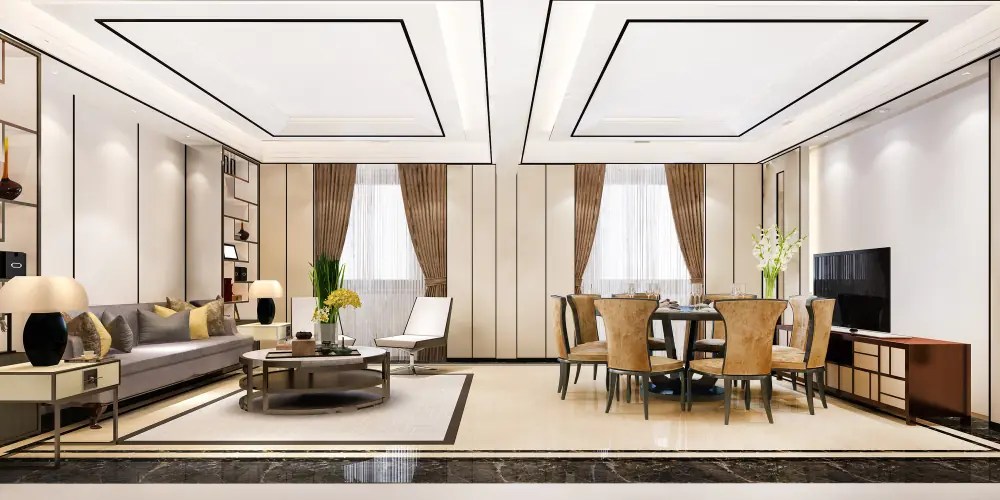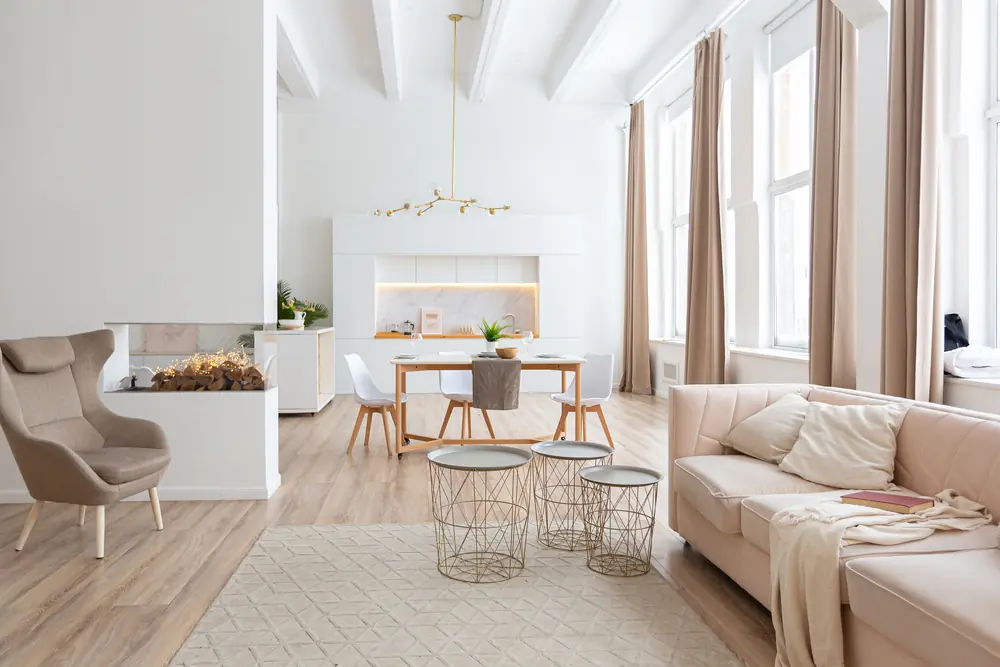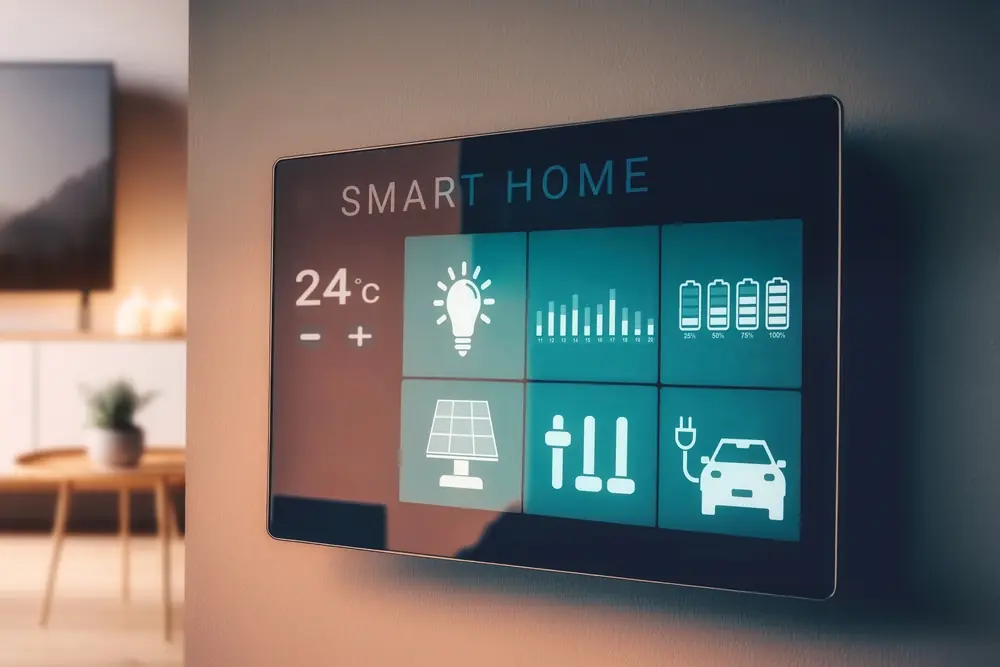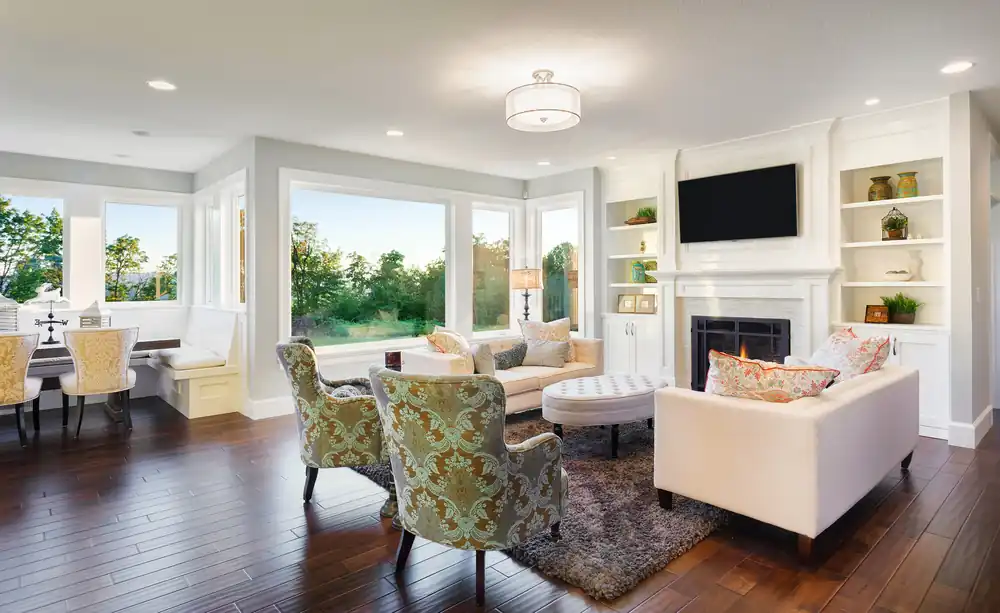How to Transform Your Home with the Latest Interior Design Trends

Welcome to our guide on transforming your home with the latest interior design trends! Interior design plays a vital role in turning houses into homes, creating spaces that are not just aesthetically pleasing but also functional and reflective of your personality. In this blog section, we’ll explore the exciting world of interior design, uncovering the hottest trends that are currently making waves.
From sustainable design practices to the beauty of minimalism, there’s a wealth of ideas to discover. Whether you’re into vibrant colors and patterns or fascinated by smart home tech, we’ve got you covered. Our article will explore these trends in detail, offering practical tips for bringing them into your own home. So, whether you’re looking to add a pop of color or streamline with technology, we’ll help you make it happen! So, get ready to be inspired and transform your home into a haven that perfectly suits your style and needs!
Understanding the Importance of Interior Design
Interior design isn’t just about picking out furniture and décor—it’s about creating spaces that are both beautiful and practical. From furniture layout to color choices, every detail is carefully planned to enhance usability and visual appeal. Effective interior design can transform even small spaces, maximizing their potential for everyday use.
Our surroundings deeply impact our mood, productivity, and well-being, and interior design plays a significant role in this. A well-designed space can uplift our spirits, boost productivity, and promote relaxation. Whether it’s through calming colors and natural materials or vibrant patterns that inspire creativity, thoughtful design choices can make a difference. Features like ample natural light and comfortable seating further enhance comfort, contributing to overall well-being.
Keeping up with the newest interior design trends is essential to maintaining your home’s style and inviting appeal in today’s fast-paced environment. You can add a contemporary touch that expresses your own personality to your living areas by embracing novel color schemes, materials, and design ideas. Furthermore, keeping your property modern will increase its market value and attract purchasers looking for modern decor. It’s not only about personal preference. It is so imperative to keep up with trends, whether you’re selling or just trying to create an environment that feels new.
Incorporating Sustainable Design Practices
Sustainability isn’t just a buzzword anymore; it’s a way of life. And when it comes to interior design, embracing sustainable practices isn’t just about being trendy—it’s about making a positive impact on the environment while creating a beautiful living space that nurtures both you and the planet. So, let’s dive into why sustainability matters in interior design, explore some eco-friendly materials and practices, and get inspired by some sustainable design trends that can truly transform your home.
Importance of Sustainability in Interior Design
When we talk about sustainability in interior design, we’re talking about making choices that minimize our environmental footprint. It’s about using resources responsibly, reducing waste, and creating healthier living environments for ourselves and future generations. By opting for sustainable design practices, you’re not only contributing to a greener planet but also fostering a sense of mindfulness and well-being in your home.
Overview of Eco-Friendly Materials and Practices
Nowadays, there’s a plethora of eco-friendly materials and practices available for homeowners looking to embrace sustainability in their interior design projects. From reclaimed wood and recycled glass to low-VOC paints and energy-efficient lighting, the options are endless. By choosing materials that are responsibly sourced, renewable, or recycled, you can reduce your carbon footprint and create a healthier indoor environment for you and your family.
Examples of Sustainable Design Trends
So, what do sustainable design trends look like in action? Here are a few inspiring ideas to get you started:
- Upcycled Furniture: Instead of buying new furniture, consider giving old pieces a new lease on life through upcycling. Whether it’s repainting an old dresser, reupholstering a vintage sofa, or turning reclaimed wood into a statement piece, upcycling not only reduces waste but also adds character and charm to your home.
- Biophilic Design: Biophilic design, which incorporates elements of nature into indoor spaces, is not only aesthetically pleasing but also inherently sustainable. From incorporating indoor plants and natural materials to maximizing natural light and ventilation, biophilic design can help improve indoor air quality, reduce stress, and promote overall well-being.
- Energy-Efficient Appliances: Investing in energy-efficient appliances not only helps lower your utility bills but also reduces your home’s energy consumption and environmental impact. Look for appliances with ENERGY STAR certification, which indicates that they meet strict energy efficiency criteria set by the Environmental Protection Agency (EPA).
By incorporating sustainable design practices into your home, you can create a space that not only looks beautiful but also feels good to live in. So, whether you’re renovating your entire home or just making small changes, remember that every eco-friendly choice you make brings us one step closer to a greener, more sustainable future.

Embracing Minimalism
Minimalism goes beyond just a design trend; it’s a lifestyle choice that can transform your home into a peaceful sanctuary. At its core, minimalism focuses on simplicity, functionality, and decluttering. By eliminating unnecessary items and embracing clean lines and neutral colors, you can create a sense of calm and spaciousness in your living spaces.
One of the main benefits of minimalist design is the creation of serene and clutter-free environments. By reducing visual noise and being intentional about what you bring into your home, you can promote a sense of calmness and clarity. Minimalist design also encourages mindfulness in your living space, fostering a deeper appreciation for the things that truly matter to you.
Incorporating minimalist elements into your home is easier than you think. In the living room, declutter surfaces and opt for sleek, multifunctional furniture pieces. In the bedroom, invest in storage solutions and stick to a minimalist color scheme with simple bedding and décor. In the kitchen, keep countertops clear and opt for minimalist cabinetry and durable materials.
By embracing minimalism, you can create a serene and tranquil environment that promotes relaxation and well-being. So why not start decluttering and simplifying your space today?
Exploring Biophilic Design
In recent years, biophilic design has gained popularity as a way to bring the outdoors into our indoor spaces, enhancing our connection to nature. This design approach involves incorporating natural elements like plants, organic materials, and natural light into our homes to improve our well-being.
Studies have shown that biophilic design offers psychological and health benefits. Exposure to nature, even in small doses, can reduce stress, boost mood, and increase productivity. Indoor plants can improve air quality by removing toxins and releasing oxygen, while natural light promotes better sleep patterns and enhances vitamin D production for a healthier immune system.
So, how can we integrate biophilic design into our homes? One approach is to introduce houseplants, whether as scattered accents or creating a lush indoor garden. Additionally, using natural materials like wood, stone, or bamboo for furniture and accents adds warmth and texture, fostering a sense of connection to the natural world. Maximizing natural light by opting for light-filtering window treatments and strategically placing mirrors can also brighten and open up spaces, further enhancing the biophilic atmosphere.
By embracing biophilic design, we can transform our living spaces into harmonious environments that promote well-being and connection to nature.
Bold Colors and Patterns
Are you ready to add some life and personality to your home? Let’s explore the vibrant world of interior design trends and discover how you can infuse your space with energy and character.
First, let’s talk about color trends. Whether you prefer calming pastels or daring jewel tones, there’s a spectrum of hues to choose from. Consider how different colors can evoke specific emotions – soft blues for tranquility or vibrant yellows for energy.
Now, let’s discuss how to incorporate these colors and patterns into your home. Start small with accessories like throw pillows and artwork to add pops of color without overwhelming the space. For a bolder statement, try introducing colorful furniture pieces or experimenting with accent walls.
Ultimately, decorating with bold colors and patterns is about embracing creativity and self-expression. Your home should reflect your unique personality, so let it shine with vibrant hues and eye-catching patterns!
Mixing Textures and Materials
When transforming your home with the latest interior design trends, don’t overlook the power of mixing textures and materials. Texture adds depth and visual interest, while combining different materials creates a dynamic environment. Whether it’s the roughness of a woven rug, the smoothness of marble, or the softness of velvet, each texture brings its own character to a room.
Popular textures and materials include rough wood, sleek glass, plush velvet, hard ceramic, and shiny metallic accents. To mix them effectively, aim for balance, stick to a cohesive color palette, consider scale, layer wisely, and mix textiles for added comfort.
By incorporating a variety of textures and materials and following these tips, you can create a visually engaging space that reflects your personal style. So let your creativity flow and transform your home with the latest interior design trends!
Elevating the Design Process
Technology isn’t just a tool; it’s a game-changer in the design process. An exceptional firm recognizes how to harness technology to enhance every step of the journey. From conceptualization to execution, we explore how these tools streamline workflows, foster collaboration, and ultimately contribute to elevated design outcomes. It’s about more than just creating a visually appealing space; it’s about crafting an experience that resonates with your brand and clientele.

Smart Home Technology Integration
Smart home technology is a rapidly evolving field, constantly introducing new innovations to the market. From intelligent thermostats to security cameras with facial recognition, there’s no shortage of gadgets to choose from. Staying up-to-date with these trends ensures you’re always at the forefront of technological advancement in your home.
Integrating smart technology into your interior design offers numerous benefits. Firstly, it enhances convenience by allowing you to control various aspects of your home effortlessly. Picture adjusting lighting, temperature, and even your music playlist with just a few taps on your smartphone or a simple voice command.
Moreover, smart home devices can significantly improve energy efficiency, ultimately reducing utility bills and minimizing your carbon footprint. For example, smart thermostats learn your heating and cooling preferences over time, optimizing energy usage and saving you money in the long run.
Additionally, smart technology enhances security and peace of mind. With smart locks, cameras, and doorbell systems, you can monitor your home remotely and receive instant alerts in case of any suspicious activity. This added layer of security allows you to relax and enjoy peace of mind, whether you’re at home or away.
The possibilities for smart home devices are virtually endless, catering to various needs and preferences. Some popular examples include:
- Smart lighting systems that allow you to adjust the color, brightness, and schedule of your lights from your smartphone or voice assistant.
- Intelligent thermostats that learn your heating and cooling patterns, automatically adjusting to optimize comfort and energy efficiency.
- Voice-controlled assistants like Amazon Alexa or Google Assistant, which can help you manage your smart devices, play music, set reminders, and much more.
- Home security cameras with features like motion detection, night vision, and two-way audio, providing comprehensive surveillance and peace of mind.
- Smart kitchen appliances such as refrigerators with built-in touchscreens and cameras, allowing you to check what’s inside from anywhere and even create shopping lists.
By integrating these smart home devices seamlessly into your interior design, you can create a home that’s not only stylish and comfortable but also technologically advanced and efficient. Embrace the future of living with smart home technology and experience the ultimate blend of luxury and convenience.
Personalization and Customization
In the world of interior design, personalization is key to creating a space that truly feels like home. Your living space should reflect your personality, interests, and style preferences, making it a place where you feel comfortable and inspired. Here, we’ll explore the importance of personalization in interior design and provide some creative ways to infuse your unique personality into your home.
Importance of Personalization in Interior Design
Your home is an extension of yourself, so it’s essential to infuse it with elements that speak to who you are. Personalization adds warmth, character, and individuality to your living space, transforming it from a generic setting into a place that feels uniquely yours. Whether you prefer sleek modern designs or cozy rustic vibes, incorporating personalized touches allows you to create a space that resonates with you on a deeper level.
Ways to Infuse Personality into Your Living Space
- Display Personal Mementos: Showcase your favorite photos, souvenirs from travels, or family heirlooms as decorative accents throughout your home. These personal mementos not only add visual interest but also evoke cherished memories and experiences.
- Expressive Artwork: Choose artwork that speaks to your interests and passions, whether it’s a vibrant abstract painting, a quirky sculpture, or a collection of vintage posters. Artwork is a powerful way to infuse personality and creativity into your space.
- Mix and Match Styles: Don’t be afraid to mix different design styles and elements that resonate with you. Blend modern furniture with vintage finds, or incorporate eclectic pieces that reflect your diverse tastes. Embracing variety adds depth and character to your interiors.
- DIY Projects: Get creative with DIY projects to personalize your home decor. Whether it’s upcycling old furniture, crafting unique wall art, or sewing custom throw pillows, DIY projects allow you to add a personal touch while showcasing your skills and creativity.
- Customize Color Palette: Choose colors that resonate with you on a personal level and reflect your mood and personality. Whether you prefer bold and vibrant hues or soft, soothing tones, selecting a custom color palette sets the tone for your space and creates a cohesive look that feels uniquely yours.
Customization Options for Furniture, Artwork, and Décor Items
- Custom Furniture: Invest in custom furniture pieces that are tailored to your specific needs and preferences. Whether it’s a bespoke sofa, a handcrafted dining table, or a custom-built bookcase, personalized furniture allows you to create functional and stylish solutions that suit your lifestyle.
- Commissioned Artwork: Work with local artists or artisans to commission custom artwork that complements your home decor and reflects your personal style. From paintings and sculptures to murals and installations, commissioned artwork adds a one-of-a-kind touch to your space.
- Personalized Décor Items: Explore customization options for decor items such as throw pillows, blankets, rugs, and accessories. Whether it’s monogrammed linens, custom-printed wallpaper, or personalized signage, these small details can make a big impact and enhance the overall ambiance of your home.
Incorporating personalization and customization into your interior design allows you to create a home that feels uniquely yours. By infusing your personality, interests, and style preferences into your living space, you’ll not only enhance its aesthetic appeal but also create a welcoming and inspiring environment that reflects who you are.
Creating Functional and Multi-Purpose Spaces
When it comes to transforming your home with the latest interior design trends, creating functional and multi-purpose spaces is key. Not only does it maximize the use of your living areas, but it also adds versatility and efficiency to your home. Let’s dive into why functionality is so important in interior design and explore some tips for optimizing your space.
Functionality isn’t just about making your home look good; it’s about making it work for you. A well-designed space should cater to your lifestyle and needs, whether you’re relaxing, entertaining guests, or working from home. By prioritizing functionality, you can ensure that every inch of your home is utilized effectively, leading to a more comfortable and convenient living environment.
Tips for Optimizing Space and Creating Multi-Functional Areas
- Assess Your Needs: Before making any design decisions, take the time to assess how you use each room in your home. Identify any areas that are underutilized or lacking in functionality.
- Think Vertically: When space is limited, look for opportunities to maximize vertical storage. Consider installing shelves or cabinets that extend from floor to ceiling to make the most of wall space.
- Invest in Multi-Functional Furniture: Opt for furniture pieces that serve more than one purpose. For example, a sofa bed or a coffee table with built-in storage can help save space and add versatility to your living room.
- Embrace Open Concept Design: Knocking down walls to create an open-concept layout can make your home feel more spacious and adaptable. This allows for seamless flow between different areas and encourages multi-functional use of space.
- Use Room Dividers: If you need to separate areas within an open-concept space, consider using room dividers or screens. These can provide privacy and definition without sacrificing the sense of openness.
Examples of Versatile Furniture and Storage Solutions
- Ottoman with Storage: An ottoman that doubles as a storage unit is a perfect addition to any living room. Not only does it provide extra seating, but it also offers a discreet place to store blankets, magazines, or other items.
- Murphy Bed: Ideal for small bedrooms or guest rooms, a Murphy bed can be folded up into the wall when not in use, freeing up valuable floor space during the day.
- Modular Shelving Systems: Modular shelving allows you to customize your storage solutions to fit your specific needs. Mix and match different components to create a configuration that works for you.
- Convertible Dining Tables: A dining table that can be extended or folded down to accommodate different numbers of guests is a great space-saving solution for smaller homes or apartments.
By incorporating these tips and examples into your home design, you can create spaces that are not only stylish but also highly functional and adaptable to your lifestyle. Whether you’re working with a small apartment or a spacious house, optimizing space and embracing multi-functionality is the key to transforming your home with the latest interior design trends.

Enhancing Lighting Design
When it comes to transforming your home with the latest interior design trends, lighting plays a crucial role that often goes overlooked. The right lighting can truly elevate the look and feel of a space, making it more inviting, comfortable, and visually appealing. In this section, we’ll delve into the importance of lighting in interior design, explore various types of lighting fixtures, and provide practical tips for enhancing both natural and artificial lighting in your home.
Importance of Lighting in Interior Design
Lighting isn’t just about illuminating a room; it’s about creating ambiance, highlighting architectural features, and setting the mood. In fact, lighting can significantly impact the way we perceive and experience a space. Properly executed lighting design can make a small room feel larger, a dark room feel brighter, and a cold room feel warmer.
Whether you’re working, relaxing, or entertaining guests, having the right lighting can make all the difference. From enhancing productivity in home offices to creating a cozy atmosphere in living rooms, lighting plays a key role in shaping the functionality and aesthetics of your home.
Overview of Different Types of Lighting Fixtures
There are various types of lighting fixtures, each serving a different purpose and contributing to the overall lighting scheme of a room. Here are some common types of lighting fixtures you might consider incorporating into your home:
- Ambient Lighting: Ambient lighting provides overall illumination to a room. This could include ceiling-mounted fixtures, recessed lighting, or wall sconces that evenly distribute light throughout the space.
- Task Lighting: Task lighting is designed to illuminate specific areas where activities such as reading, cooking, or working take place. Examples of task lighting fixtures include desk lamps, under-cabinet lighting in kitchens, and pendant lights over workspaces.
- Accent Lighting: Accent lighting is used to highlight architectural features, artwork, or decorative elements within a room. This could include track lighting, picture lights, or adjustable wall-mounted fixtures that draw attention to focal points.
- Decorative Lighting: Decorative lighting fixtures serve as both functional and aesthetic elements in interior design. These could range from chandeliers and pendant lights to decorative floor lamps that add personality and style to a room.
Tips for Enhancing Natural and Artificial Lighting in Your Home
- Maximize Natural Light: Make the most of natural light by strategically placing mirrors to reflect sunlight, choosing light-colored window treatments that allow light to filter through, and keeping windows clean and unobstructed.
- Layer Your Lighting: Create depth and dimension in your lighting design by layering different types of lighting fixtures. Combine ambient, task, and accent lighting to achieve the perfect balance of functionality and ambiance.
- Use Dimmers and Smart Controls: Install dimmer switches and smart lighting controls to adjust the intensity and color temperature of your artificial lighting according to your needs and preferences throughout the day.
- Experiment with Bulbs: Explore different types of light bulbs, such as LED, incandescent, and halogen, to find the right balance of brightness and warmth for each room in your home.
By paying attention to the lighting design in your home and incorporating these tips, you can create a space that is not only visually stunning but also functional and inviting for all who enter.
Conclusion
As we conclude our discussion on transforming your home with the latest interior design trends, let’s recap the key points. We’ve highlighted the importance of staying updated with evolving trends, from sustainability to minimalist aesthetics and smart home technology. Now, it’s time to take action. Start incorporating these trends into your space to create a stylish and functional home that reflects your personality. If you need assistance, reach out to professionals like Outbuild Interior. Let’s embark on this journey together and turn your house into a modern haven.


